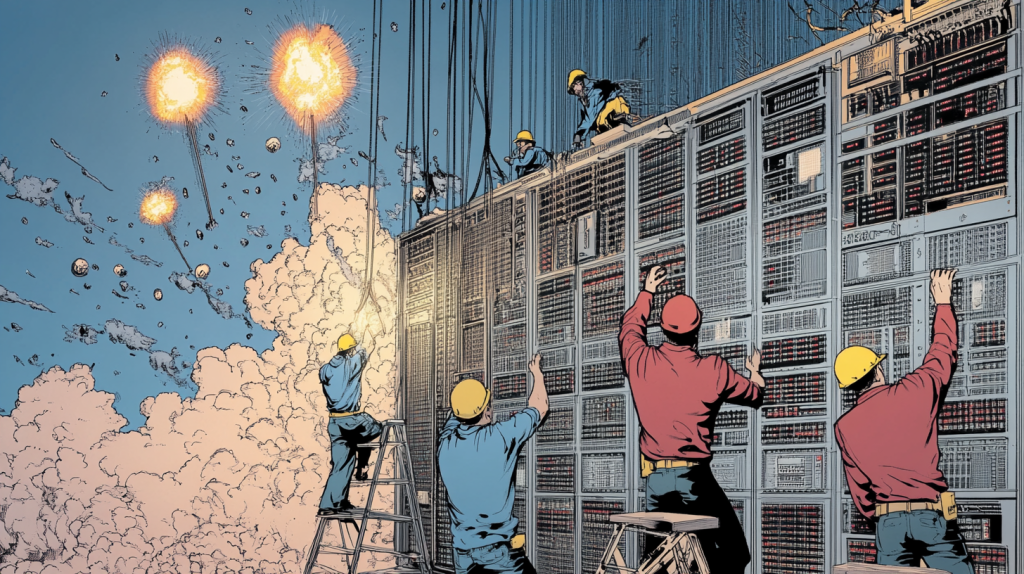Data Center Construction Crew Scheduling: How Superintendents Can Optimize Team Productivity on Complex Data Center Projects
Table of Contents:

Managing crew schedules in data center construction is no small task. With multiple trades working simultaneously, strict timelines, and mission-critical infrastructure to install, superintendents must balance efficiency with flexibility. One scheduling mistake can delay the entire project, increase labor costs, and create worksite bottlenecks.
The key to successful crew scheduling lies in strategic workforce planning, real-time adjustments, and the integration of scheduling technology that keeps superintendents in full control of labor assignments. Whether it’s coordinating electrical teams with HVAC crews, aligning IT infrastructure installation with structural phases, or ensuring that material deliveries match labor availability, an optimized scheduling strategy can make the difference between a project running smoothly and one falling behind.
This guide explores best practices for crew scheduling, helping superintendents optimize team productivity, reduce downtime, and streamline complex data center projects.
Understanding the Challenges of Crew Scheduling in Data Center Construction
Unlike standard commercial construction, data centers require specialized crews for tasks such as power distribution, precision cooling installation, and network infrastructure deployment. These systems must be installed in a specific sequence, meaning that any misalignment in workforce scheduling can cause serious disruptions.
A common challenge is overlapping schedules between different trade teams. If electricians arrive before the necessary switchgear is installed, or HVAC technicians are scheduled before cooling systems arrive, crews sit idle. Likewise, having too many workers in one area can slow progress, creating safety hazards and logistical bottlenecks.
Another issue is last-minute changes due to weather delays, supply chain disruptions, or unexpected project modifications. Without flexible scheduling systems in place, these changes can lead to wasted labor hours and project overruns.
By adopting dynamic scheduling practices, superintendents can avoid these pitfalls and ensure that every crew member is where they need to be, when they need to be there.
Key Benefits
- Reduces project delays by ensuring crews work in the right sequence
- Improves labor efficiency and minimizes downtime
- Enhances communication between superintendents and trade teams
Best Practices
- Use real-time scheduling tools to adjust assignments as needed
- Align workforce schedules with material delivery timelines
- Conduct weekly planning meetings to coordinate trade schedules
Effective crew scheduling is essential for keeping data center projects on track. With the right approach, superintendents can improve labor efficiency, prevent costly delays, and ensure seamless coordination across all trades.
Related Articles:
Best Guide to Data Center Construction Management Software: Manage Scheduling, Deliveries, and Compliance for Hyperscale Projects
Data Center Construction Deliveries: Best Real-Time Tracking Solutions for Managing Data Center Construction Deliveries
Data Center Construction: Top Delivery and Scheduling Strategies for Redundant Power Systems in Data Centers

Leveraging Technology for Smarter Crew Scheduling
Manual scheduling methods, such as spreadsheets and whiteboards, are outdated and prone to errors. Modern data center construction demands real-time coordination, which is why many superintendents are turning to digital scheduling platforms that offer live workforce tracking, automated shift assignments, and predictive scheduling insights.
Digital scheduling tools allow crews to receive real-time updates on task assignments, ensuring that no one is left waiting due to scheduling mismatches. These platforms also provide an overview of workforce availability, making it easier to adjust schedules dynamically based on project needs.
By integrating crew scheduling software with workforce management systems, superintendents can optimize labor planning while minimizing disruptions caused by unforeseen delays.
Key Benefits
- Reduces scheduling errors by automating workforce assignments
- Improves job site visibility for superintendents
- Enhances flexibility in adapting to schedule changes
Best Practices
- Implement digital scheduling software to track workforce allocation
- Use mobile scheduling apps to update crew assignments in real time
- Integrate scheduling tools with project management platforms for seamless coordination
Technology-driven scheduling solutions simplify workforce coordination, helping superintendents manage complex projects with greater efficiency and accuracy.
Related Articles:

Aligning Workforce Schedules with Project Phases
Scheduling crews without considering the specific phases of data center construction can lead to unnecessary delays. Each phase—foundation work, structural steel installation, mechanical and electrical work, IT infrastructure setup, and commissioning—requires the right personnel at the right time.
One of the best ways to improve crew productivity is by aligning labor schedules with project milestones. This ensures that every task is completed in the correct sequence without delays caused by trade team conflicts or missing infrastructure.
For example, electrical teams should be scheduled only after key power components, such as transformers and switchgear, have arrived. Similarly, IT teams should be deployed only after cooling infrastructure is fully installed to prevent overheating risks.
Key Benefits
- Prevents workforce idling by aligning labor needs with project readiness
- Reduces scheduling conflicts between overlapping trades
- Ensures that crews arrive at job sites only when needed, avoiding delays
Best Practices
- Use phased scheduling plans to align crew assignments with project timelines
- Work closely with procurement teams to schedule labor based on material availability
- Conduct daily or weekly planning sessions to adjust workforce allocations
Aligning crew schedules with project phases ensures that no team arrives too early or too late, allowing construction to progress smoothly and efficiently.
Managing Shift-Based Scheduling for Large-Scale Data Center Builds
In large-scale data center construction, shift-based scheduling is essential for keeping projects on track, maximizing labor productivity, and ensuring that critical tasks are completed without delays. Unlike standard commercial projects, data centers operate on tight deadlines with 24/7 work cycles, meaning that scheduling needs to be strategic, flexible, and well-coordinated to avoid worksite congestion and labor inefficiencies.
How Shift-Based Scheduling Improves Crew Efficiency
Superintendents who implement shift-based scheduling can ensure continuous workflow without worker fatigue or excessive overtime. Instead of cramming all work into a single daytime shift, staggering crews across multiple shifts allows for around-the-clock progress while maintaining compliance with labor regulations.
For example, structural and electrical work can be performed during the day, while IT infrastructure and commissioning tasks may be best scheduled for overnight shifts to prevent interference with heavy construction activities. This approach also allows superintendents to optimize worksite capacity by limiting the number of trades on-site at the same time.
Another key benefit of shift-based scheduling is adapting to environmental conditions. In locations with extreme heat or cold, superintendents can schedule work during off-peak temperature hours, ensuring worker safety and optimal productivity.
Key Benefits
- Enables 24/7 project progress without burnout or inefficiencies.
- Reduces crew congestion by distributing workloads across different shifts.
- Prevents overtime costs and ensures compliance with labor regulations.
Best Practices
- Implement rotating shift schedules to avoid worker exhaustion.
- Use real-time workforce tracking tools to monitor shift performance.
- Schedule off-peak construction tasks for night shifts to optimize workflow.
Shift-based scheduling ensures that data center construction crews maintain productivity, reduce fatigue, and keep complex projects moving forward efficiently.

Avoiding Scheduling Conflicts Between Trade Teams
One of the biggest challenges in crew scheduling is ensuring that multiple trade teams—electricians, HVAC specialists, IT installers, and structural crews—don’t interfere with each other’s work. Without proper coordination, scheduling conflicts can bring productivity to a halt, leading to delays, inefficiencies, and costly rework.
How to Prevent Scheduling Conflicts
Trade teams often work in the same spaces at different times, which means their schedules must be carefully aligned. If HVAC technicians begin installing cooling infrastructure before the power distribution network is completed, they may have to undo and redo work, wasting valuable time.
To avoid these issues, superintendents should:
- Develop phased scheduling plans that sequence each trade’s work logically.
- Use scheduling software to visualize workforce allocations and detect conflicts early.
- Hold weekly coordination meetings with trade supervisors to ensure alignment.
Superintendents can also use real-time scheduling platforms that allow teams to track job progress, receive instant updates, and adjust timelines dynamically when unexpected delays occur.
Key Benefits
- Reduces delays caused by scheduling overlaps between trade teams.
- Improves communication between field crews and project managers.
- Ensures smooth workflow transitions across different construction phases.
Best Practices
- Align workforce schedules with project milestones to prevent task interference.
- Use trade-specific scheduling buffers to prevent congestion in shared workspaces.
- Monitor crew progress with real-time job site tracking tools.
Avoiding scheduling conflicts ensures that trade teams work efficiently, minimizing disruptions and keeping data center construction projects on schedule.
Related Articles:
Best Guide to Construction Management Software
Data Center Construction Delivery Coordination: Efficient Scheduling Strategies for Modular Data Center Equipment Installations
The Best Guide to Delivery Management Systems (DMS) for Commercial Construction
Superintendents: Effective Training Strategies for Construction Management Software Users

Using AI and Predictive Analytics for Crew Scheduling
Artificial Intelligence (AI) is revolutionizing crew scheduling in data center construction by predicting labor needs, optimizing shift assignments, and identifying potential scheduling conflicts before they occur. Instead of relying on static spreadsheets or manual scheduling, AI-driven tools help superintendents forecast labor demand, prevent bottlenecks, and improve workforce efficiency.
How AI Improves Crew Scheduling
- Predicting Crew Availability – AI analyzes historical workforce trends to anticipate labor shortages or skill gaps before they become a problem.
- Automated Schedule Adjustments – If a delay in one phase affects downstream work, AI automatically reschedules crews to prevent downtime.
- Optimizing Labor Utilization – AI ensures that each worker is assigned to the right task at the right time, maximizing productivity.
- Workload Balancing – AI helps distribute workloads evenly across shifts, preventing overstaffing in some areas and labor shortages in others.
By integrating AI-powered workforce scheduling platforms, superintendents can increase project efficiency, reduce overtime costs, and minimize disruptions.
Key Benefits
- Enhances scheduling accuracy by using predictive analytics.
- Reduces labor shortages and overstaffing risks.
- Optimizes crew assignments for better efficiency and productivity.
Best Practices
- Use AI-powered scheduling platforms to automate crew assignments.
- Integrate predictive analytics into workforce planning.
- Monitor real-time job site conditions to adjust schedules dynamically.
AI-driven scheduling allows superintendents to proactively manage workforce allocation, ensuring that every crew member is assigned to the most critical tasks at the right time.
Improving Communication Between Superintendents and Field Crews
A well-coordinated construction project depends on clear, real-time communication between superintendents and field crews. If instructions aren’t effectively relayed, teams may misinterpret schedules, overlook key details, or fall behind on tasks.
Challenges in Superintendent-to-Crew Communication
- Lack of real-time updates – Without mobile communication tools, field crews may not receive last-minute scheduling changes in time.
- Worksite noise and distractions – Busy job sites make verbal communication difficult, leading to misunderstandings and task delays.
- Disconnected teams – Remote project sites often struggle with weak cell signals or limited internet access, making it difficult for superintendents to coordinate with workers.
Best Ways to Improve Communication
- Use Mobile Workforce Apps – Mobile scheduling tools keep all crew members updated on task assignments, shift changes, and project milestones.
- Enable Real-Time Task Tracking – Digital dashboards allow superintendents to monitor job progress and make immediate adjustments as needed.
- Hold Daily Briefings – Quick morning meetings before shifts ensure that every crew member knows their assignments and project priorities.
Key Benefits
- Enhances real-time communication between superintendents and field teams.
- Reduces errors caused by miscommunication.
- Improves crew response time to scheduling changes.
Superintendents who implement mobile communication tools and real-time tracking can keep teams better informed, reduce scheduling confusion, and improve overall project efficiency.

Unlock the Full Potential of Your Construction Projects with StruxHub
StruxHub enhances efficiency and coordination across all project phases, providing a single source of truth that eliminates silos and fosters collaboration. Real-time updates, financial management tools, and seamless commvunication features ensure that all team members and stakeholders are aligned and informed, reducing the risk of errors and delays. With comprehensive solutions for document management, risk mitigation, and quality control, StruxHub maintains project integrity and safety, while mobile access and integration capabilities further enhance project flexibility and efficiency.
StruxHub’s Key Features and Benefits:
- Advanced Delivery Management: Automate and optimize your delivery schedules, ensuring materials arrive just in time, every time.
- Site Communication: Utilize georeferenced maps and instant messaging to keep every team member informed and aligned.
- Construction Materials Management: Track inventory levels and manage materials procurement with ease, reducing waste and avoiding project delays.
- Construction Safety & Inspection Workflows: Implement customizable mobile forms for conducting safety inspections and managing compliance documentation effortlessly.
- Short-Term Scheduling: Visualize project tasks with detailed floor plans, linking each activity to specific locations for better planning accuracy.
- Construction Resource Management: Efficiently allocate personnel and equipment, maximizing productivity and reducing idle time.
StruxHub’s Product Offering:
- StruxHub Deliveries: Simplifies the coordination of incoming deliveries, ensuring materials and equipment are precisely timed to project needs.
- StruxHub Logistics: Offers intelligent site logistics planning, from crane scheduling to space allocation, for smoother operations.
- StruxHub Safety: Elevates on-site safety standards with easy-to-use tools for inspections, permits, and incident reporting.
- StruxHub Scheduling: Enhances project timelines with intuitive scheduling tools that ensure tasks are completed efficiently and on time.
With StruxHub, construction companies can look forward to a streamlined, more efficient project execution that delivers on time and within budget. Embrace the power of innovation and take your construction projects to the next level.
Don’t miss out on the opportunity to optimize your construction management processes with StruxHub. Sign up for a free demo today. Let’s build smarter, together.

StruxHub
Experience the power of StruxHub today and witness firsthand how it can revolutionize your construction operations.
FAQ
Why is crew scheduling important in data center construction?
Crew scheduling is one of the most critical components of data center construction because these projects involve multiple trade teams working in precise phases. Unlike standard construction projects, data centers require a high degree of coordination between structural, mechanical, electrical, and IT infrastructure teams to ensure that everything is installed in the correct sequence.
Without proper scheduling, trade teams may overlap, causing worksite congestion, safety risks, and delays that can push a project over budget. For example, if HVAC installers begin work before the electrical infrastructure is in place, they may be forced to redo installations, leading to unnecessary labor costs and extended project timelines.
Another reason why scheduling is vital is that data centers often have tight deadlines and penalty clauses for late completion. If a cloud service provider or colocation facility expects a data center to be operational within 18 to 24 months, any mismanagement in workforce scheduling can create cascading delays, affecting not only the construction team but also the client’s business operations.
Technology plays a huge role in modern crew scheduling, with AI-driven scheduling platforms allowing superintendents to track workforce availability, automate shift planning, and adjust schedules in real time. These tools also integrate with project management software, ensuring that crews are aligned with material deliveries and project milestones.
By optimizing crew scheduling, superintendents can prevent costly rework, ensure efficient labor utilization, and maintain construction momentum, all while improving overall job site safety and productivity.
What are the most common scheduling mistakes in data center projects?
Scheduling mistakes in data center construction can be costly, leading to delays, budget overruns, and worker inefficiencies. The most common mistakes include poor coordination between trade teams, failing to adjust schedules based on real-time project needs, and underestimating labor requirements for mission-critical tasks.
One of the biggest pitfalls is overlapping schedules between multiple crews, where trade teams compete for the same workspace at the same time. For instance, if electrical and cooling teams are scheduled simultaneously in a confined area, their workflows can interfere with each other, leading to bottlenecks and unnecessary downtime.
Another common issue is failing to account for material delays. If a key shipment—such as electrical switchgear or backup generators—arrives late, the crew assigned to that installation may be left waiting, wasting valuable labor hours. To prevent this, superintendents must align workforce schedules with delivery tracking systems, ensuring that crews are deployed only when materials are available and installation can proceed without delays.
Underestimating labor demand is another critical mistake. Data center construction often requires specialized workers, such as fiber-optic cable installers and power distribution experts, who may not always be readily available. Without proactive workforce forecasting, projects can experience labor shortages, leading to delays in commissioning and final testing.
By integrating real-time scheduling tools, predictive workforce planning, and automated crew tracking systems, superintendents can avoid these common scheduling pitfalls, ensuring that projects stay on time, within budget, and free from unnecessary workforce disruptions.
How can superintendents improve workforce coordination on remote job sites?
Managing crew coordination in remote data center projects presents unique challenges, including limited infrastructure, workforce shortages, and communication barriers. Without effective coordination, projects can experience long delays, supply chain disruptions, and inefficient crew utilization.
One of the most effective ways to improve workforce coordination is by using mobile-friendly scheduling software that allows superintendents to assign tasks, track crew availability, and make schedule changes in real-time. When working in remote areas where cellular service may be limited, having a cloud-based scheduling platform with offline capabilities ensures that teams can still access critical job details.
Another key factor is coordinating logistics and workforce deployment efficiently. Remote data centers often require pre-planned shift rotations, as workers may need to travel long distances or stay in on-site accommodations. Superintendents should plan longer but less frequent shifts to maximize crew efficiency while minimizing travel time.
Regular check-ins and virtual coordination meetings also play a huge role in keeping remote teams aligned. Whether through satellite communications, mobile workforce tracking, or digital collaboration tools, keeping crews informed about schedule updates, job site conditions, and priority tasks helps ensure smooth execution, even from a distance.
By leveraging workforce tracking technologies, optimizing shift rotations, and implementing clear communication protocols, superintendents can overcome the challenges of remote data center projects and keep work progressing efficiently.
What role does AI play in optimizing crew scheduling?
AI is transforming crew scheduling in data center construction by providing predictive insights, automated workforce planning, and real-time scheduling adjustments. Instead of relying on manual spreadsheets and static shift planning, AI-driven scheduling software enables superintendents to proactively manage labor allocation and prevent bottlenecks before they happen.
One of AI’s biggest advantages is its ability to predict scheduling conflicts by analyzing historical project data, crew performance, and material availability. If AI detects that a particular phase—such as fiber optic installation or electrical commissioning—is consistently running over schedule in similar projects, it can recommend proactive adjustments to avoid delays.
Another way AI optimizes workforce planning is through automated shift balancing. By assessing crew fatigue levels, workload distribution, and job complexity, AI can suggest optimal shift rotations, ensuring that workers are deployed efficiently while reducing overtime costs and burnout risks.
Additionally, AI-driven scheduling tools can integrate with real-time job site tracking, making automatic adjustments when unexpected disruptions occur. For example, if a shipment delay pushes back an installation task, AI can reschedule crew assignments in seconds, ensuring that workers are reassigned to other high-priority tasks instead of waiting idly.
By leveraging AI-powered workforce scheduling, superintendents can improve labor efficiency, minimize scheduling errors, and increase overall project productivity.
Which digital scheduling tools help streamline crew management?
Digital scheduling tools have become essential for superintendents managing large-scale data center construction projects. These tools eliminate manual scheduling errors, improve workforce coordination, and allow for real-time adjustments, ensuring that crews are deployed efficiently.
Some of the top digital scheduling platforms include:
- StruxHub Scheduling – Designed for construction workforce coordination, StruxHub provides real-time crew scheduling, automated shift assignments, and mobile workforce tracking to keep projects running smoothly.
- Procore Workforce Management – A robust platform that integrates labor tracking, scheduling, and compliance monitoring, helping superintendents manage multiple trade teams in complex builds.
- PlanGrid by Autodesk – Useful for field coordination and blueprint sharing, PlanGrid ensures that crew members always have updated schedules and project documents on hand.
- Oracle Primavera P6 – A high-level scheduling tool often used for mega construction projects, providing advanced scheduling analytics and predictive workforce planning.
- BIM 360 Field Management – Integrates with Building Information Modeling (BIM) platforms to align crew scheduling with project phases, reducing workflow clashes between different trades.
Using cloud-based scheduling tools helps superintendents eliminate scheduling conflicts, improve crew visibility, and maintain smooth project workflows. By selecting the right scheduling software, construction managers can ensure that every team is working efficiently, on time, and within budget.




